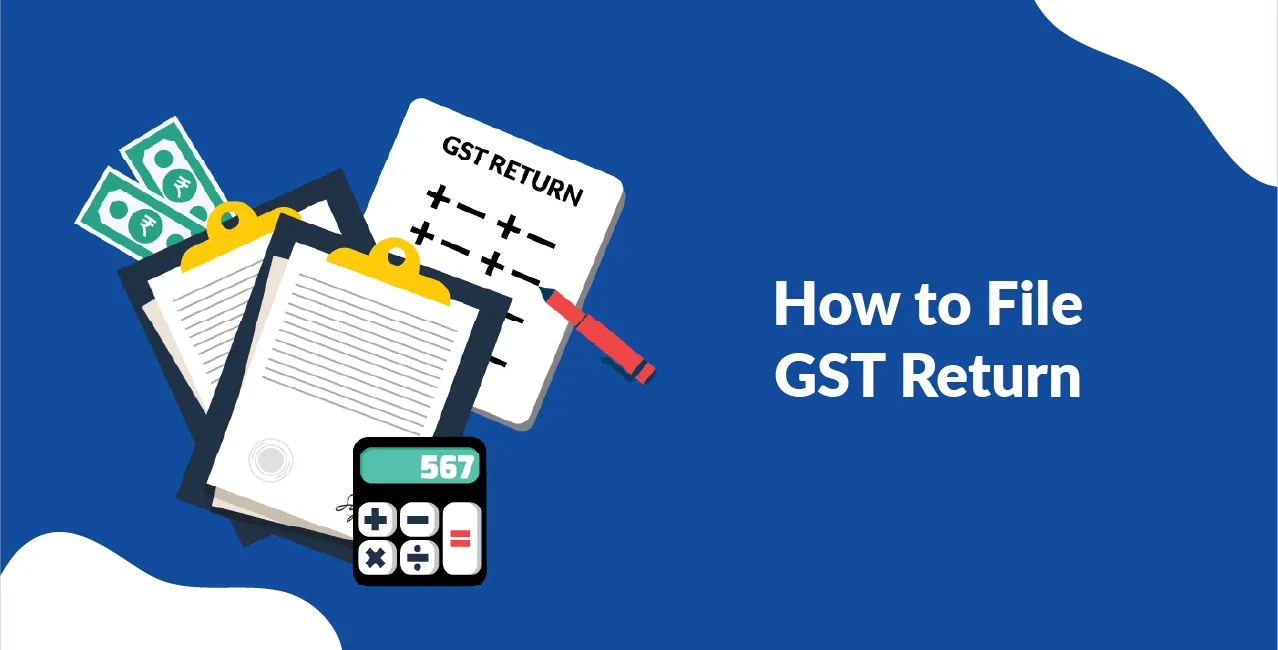Anita Deshmukh, a fashion entrepreneur from Pune, runs her boutique , which reported a turnover of ₹26 lakhs in FY 2024–25. Registered under the GST regime, Anita is legally required to file monthly GSTR-1 (sales returns)and quarterly GSTR-3B.
In April 2025, while attempting to file her March GSTR-3B, she noticed she had missed an eligible input tax credit (ITC) claim of ₹2,200 from a vendor’s invoice. This small error would’ve cost her an equivalent amount in additional tax. Recognising the significance of accurate data entry, Anita revisited all her sales and purchase records.
She used the official GST Portal, re-uploaded the corrected data, and filed an amended return the next month. This incident helped her understand how crucial timely and precise return filing is, especially for small businesses like hers that operate on tight margins. It also reinforced her commitment to monthly bookkeeping discipline.
What is a GST Return?
A GST return is a document or statement containing details of income, sales, purchases, and tax liability, submitted by registered GST taxpayers to the Goods and Services Tax Network (GSTN). These returns help the government track tax inflows, cross-check invoices, and ensure tax compliance across businesses.
Why is Filing Mandatory?
Filing returns is mandatory under the CGST Act, 2017, for all registered businesses. It enables:
- Claiming Input Tax Credit (ITC)
- Avoiding penalties and late fees
- Maintaining compliance for audits and tenders
Who Needs to File?
- Businesses with a turnover above ₹20 lakhs (₹10 lakhs in special category states)
- Composition scheme taxpayers
- Casual taxable persons and e-commerce sellers
Numerical Example:
Sanjay, a freelance IT consultant in Bengaluru, earns ₹45 lakhs annually. He must file monthly GSTR-1 and GSTR-3B, and the annual GSTR-9. Last year, due to a delay of 15 days in filing GSTR-3B for July, he incurred a late fee of ₹10,000 and lost out on timely ITC reconciliation, which affected his cash flow for the month.
Read More: How to Download GST Certificate – Step-by-Step Guide
Types of GST Returns & Their Due Dates
There are different GST returns for different taxpayer categories and activities. Understanding which return applies to your business is the first step in staying compliant.
Key GST Returns:
Return Type | Applicable For | Frequency | Due Date | Filing Mode |
GSTR-1 | Regular Taxpayers | Monthly/Quarterly | 11th of next month | Online |
GSTR-3B | Regular Taxpayers | Monthly | 20th of next month | Online |
GSTR-4 | Composition Taxpayers | Annually | 30th April (following FY) | Online |
GSTR-9 | Annual Return | Yearly | 31st December | Online |
Source: www.gst.gov.in
Example:
Meena Textiles, a family-run business in Surat, opted for the Composition Scheme, reporting an annual turnover of ₹1.3 crores. Instead of filing monthly GSTR-1 and GSTR-3B, they only need to file GSTR-4 once a year. However, they must still maintain invoice-wise records and pay tax quarterly through CMP-08. Missing the 30th April deadline led to a ₹2,000 late fee last year.
Learn More: Objectives of GST: Why Was GST Introduced in India?
Pre-requisites Before Filing a GST Return
Before you start filing returns, ensure the following steps are in place:
Requirements:
- GSTIN (GST Identification Number) is issued upon registration
- PAN and Aadhaar linkage for verification
- Updated business books/accounts
- Login credentials for www.gst.gov.in
- Valid DSC (Digital Signature Certificate) or OTP-based verification
These prerequisites help in secure login, data authentication, and a smooth portal experience.
Example:
Ravi operates a tuition academy in Chennai and earns ₹28 lakhs per annum. While preparing his GSTR-3B for March 2025, he realised a ₹12,000 purchase invoice wasn’t recorded in his accounting software. This delayed his return submission by four days, costing him a late fee of ₹800 and interest of ₹96. He has now hired a part-time accountant to ensure proper record-keeping before filing deadlines.
Also Read - GSTR 6 Return Guide
How to File GSTR-1 Online?
GSTR-1 is a detailed return that captures outward supplies—in simple terms, your monthly or quarterly sales. All regular GST-registered businesses must file it on time. Let’s walk through the process step by step:
Step-by-Step Process to File GSTR-1 Online:
- Login to the GST Portal:
- Go to www.gst.gov.in
- Use your GSTIN, username, and password to log in securely.
- Go to www.gst.gov.in
- Navigate to ‘Returns Dashboard’:
- Select the relevant financial year and return filing period (month/quarter).
- Click on GSTR-1 – Prepare Online.
- Select the relevant financial year and return filing period (month/quarter).
- Enter Invoice Details:
- Fill out all applicable sections:
- B2B (Business to Business): Add details of all taxable supplies to GST-registered buyers.
- B2C (Business to Consumer): Enter sales to unregistered customers (state-wise if above ₹2.5 lakh).
- Exports: Include all zero-rated export sales.
- NIL-rated/Exempt Supplies: For transactions not liable to GST.
- B2B (Business to Business): Add details of all taxable supplies to GST-registered buyers.
- Fill out all applicable sections:
- Upload and Save Monthly:
- You can upload invoices in bulk using Excel or JSON format or enter them manually.
- Save entries periodically to avoid data loss.
- You can upload invoices in bulk using Excel or JSON format or enter them manually.
- Use DSC or OTP to File:
- After finalising entries, click on ‘Preview’ to review.
- File the return using:
- DSC (Digital Signature Certificate) for companies
- OTP (One-Time Password) for individuals and proprietors via Aadhaar
- DSC (Digital Signature Certificate) for companies
- After finalising entries, click on ‘Preview’ to review.
Important: Once filed, the buyer can see these invoices in their GSTR-2A and claim Input Tax Credit accordingly.
Sample GSTR-1 Invoice Entry Format
Invoice No. | Date | Customer GSTIN | Invoice Value | Taxable Value | IGST | CGST | SGST |
INV2025/01 | 01-Apr-25 | 27ABCDE1234F1Z5 | ₹15,000 | ₹12,711.86 | ₹2,288.14 | - | - |
How to File GSTR-3B?
GSTR-3B is a monthly summary return used to declare overall sales, purchases (eligible for ITC), and tax payments. It is compulsory for all regular taxpayers and must be filed by the 20th of the following month.
Steps to File GSTR-3B:
- Log in to GSTN Portal:
- Visit www.gst.gov.in
- Enter your credentials and access the Return Dashboard.
- Visit www.gst.gov.in
- Go to GSTR-3B Section:
- Select the relevant period (month).
- Click on ‘Prepare Online’ or use the offline utility if bulk entry is needed.
- Select the relevant period (month).
- Fill in the Summary Details:
- Outward Supplies: Total taxable outward supplies (with and without tax).
- Inward Supplies (ITC): Enter eligible Input Tax Credit details.
- Tax Liability: The system auto-calculates based on your entries.
- Outward Supplies: Total taxable outward supplies (with and without tax).
- Preview and Pay Taxes:
- Use PMT-06 challan to pay any tax liability.
- Make sure your cash/credit ledger has sufficient balance.
- Use PMT-06 challan to pay any tax liability.
- Final Submission:
- Once confirmed, use DSC/OTP to file.
- Save the Acknowledgment Reference Number (ARN) for future reference.
- Once confirmed, use DSC/OTP to file.
Sample GSTR-3B Format:
Head | Outward Supply | Inward Supply (Eligible for ITC) | Tax Paid (₹) |
IGST | ₹30,000 | ₹12,000 | ₹18,000 |
CGST | ₹15,000 | ₹5,000 | ₹10,000 |
SGST | ₹15,000 | ₹5,000 | ₹10,000 |
Example:
Priya & Co., a Bengaluru-based marketing firm, claimed an ITC of ₹22,000 in April 2025. However, while entering GSTR-3B data, they mistakenly mentioned only ₹20,000. This mismatch caused an additional tax outflow of ₹2,000, plus ₹360 as interest due to late correction in May. This incident highlighted the importance of reconciling books with GSTR-2B before filing.
How to File Annual GST Return (GSTR-9)?
GSTR-9 is an annual return that summarises all the monthly or quarterly returns filed (like GSTR-1 and GSTR-3B) for a given financial year. It's mandatory for taxpayers with annual aggregate turnover exceeding ₹2 crores, although others can file it voluntarily.
What is GSTR-9?
- It’s a comprehensive consolidation of your yearly GST transactions, covering outward and inward supplies, ITC claimed, tax paid, and any additional liability.
- Filed once a year for the previous financial year, by 31st December.
Steps to File GSTR-9:
- Login and Navigate:
- Log in to gst.gov.in
- Go to Returns Dashboard → GSTR-9 → Prepare Online/Offline.
- Log in to gst.gov.in
- Download Data from Portal:
- The system auto-populates data from GSTR-1 and GSTR-3B.
- Cross-verify with your books of accounts, GSTR-2A/2B.
- The system auto-populates data from GSTR-1 and GSTR-3B.
- Reconcile Entries:
- Check for any mismatches in sales, ITC claims, or tax paid.
- Make corrections, if needed, in the annual return or next month’s GSTR.
- Check for any mismatches in sales, ITC claims, or tax paid.
- Preview and File:
- File using DSC/OTP after thorough verification.
- Once filed, it cannot be revised, so accuracy is crucial.
- File using DSC/OTP after thorough verification.
Penalty for Late Filing:
- ₹200/day (₹100 CGST + ₹100 SGST), up to a maximum of 0.25% of the taxpayer’s turnover.
Example:
Shankar Pvt. Ltd., an engineering goods manufacturer in Nagpur, missed filing their GSTR-9 for FY 2023–24. The return was due by 31st December 2024, but they filed it on 15th January 2025. As a result, they incurred a late fee of ₹200/day (₹100 CGST + ₹100 SGST) for 15 days, totalling ₹3,000. They also realised their ITC for the year had a shortfall of ₹12,500, which they had to absorb without a refund.
Explore More: How to Start a Business Without Money – Step-by-Step Guide
How to Check GST Return Filing Status?
Once you’ve filed a GST return (whether GSTR-1, GSTR-3B, or GSTR-9), it’s essential to check its filing status to ensure it has been processed successfully. Here's how to do it:
Ways to Track GST Return Status:
- Through the GST Portal Dashboard:
- Visit www.gst.gov.in
- Log in using your GST credentials.
- Go to Returns Dashboard → Select Financial Year & Period → View filing status (Filed, Submitted, Not Filed).
- Visit www.gst.gov.in
- Using ARN (Acknowledgement Reference Number):
- After filing a return, you receive an ARN via email/SMS.
- Go to Services → Returns → Track Return Status.
- Enter the ARN and hit “Search” to get real-time return processing updates.
- After filing a return, you receive an ARN via email/SMS.
- Email and SMS Alerts:
- The portal sends automatic updates via registered email and mobile number once a return is filed or processed.
- The portal sends automatic updates via registered email and mobile number once a return is filed or processed.
- Using GST Mobile App (Optional):
- You can also install the GST Suvidha mobile app (if available) to track your return status on the go.
- You can also install the GST Suvidha mobile app (if available) to track your return status on the go.
Conclusion:
Filing GST returns is not just a legal formality but a business-critical task that ensures smooth ITC claims, timely tax compliance, and trust with suppliers and customers. With the correct steps, tools, and understanding of due dates, taxpayers can stay compliant without stress.
FAQs:
- What is the deadline for filing GSTR-1 and GSTR-3B?
GSTR-1 is due on the 11th of the following month, and GSTR-3B by the 20th. Quarterly filers have extended timelines under QRMP. - Can I revise a GST return after filing?
No, GST returns cannot be revised, but you can use the amendment section in the next return to correct errors. - What happens if I don’t file returns on time?
You may face late fees, interest charges, and blockage of Input Tax Credit (ITC) for yourself and your buyers. - Do I need to file NIL returns if there are no transactions?
Yes, even if there is no business activity, NIL returns must be filed to avoid penalties and remain compliant. - Where can I find official GST formats and filing tools?
Always refer to the official website www.gst.gov.in for authentic formats, updates, and online return filing.
Other GST Important Pages | |||





